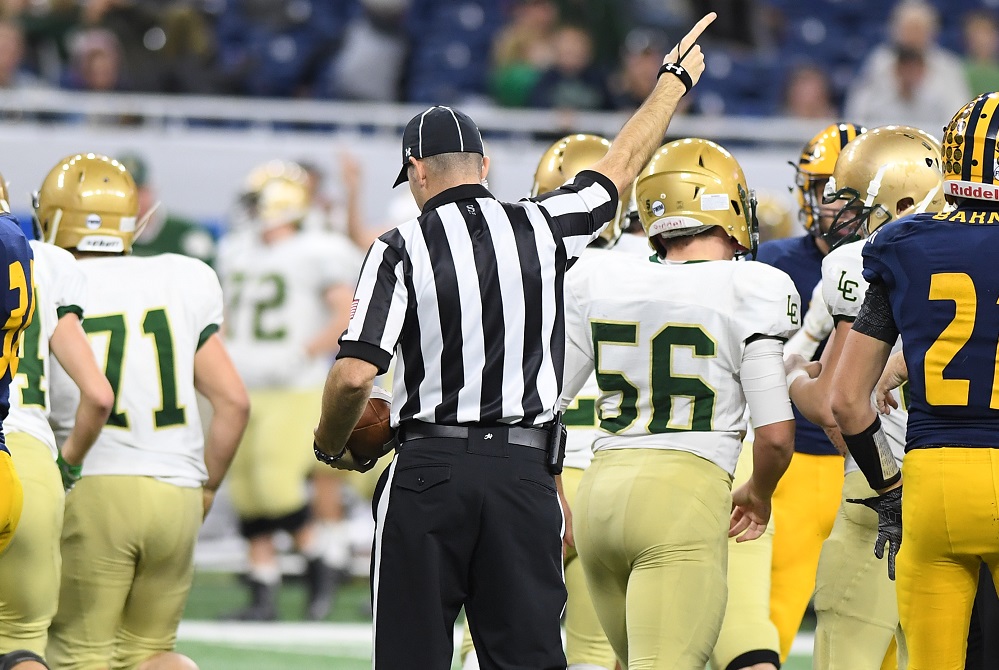
Division 7 Football Final: Blue Streak
November 26, 2011
DETROIT – Only a few drives into the MHSAA Division 7 Final, Bennett Lewis came to Saginaw Nouvel coach Mike Boyd with a request.
Give me the ball until Pewamo-Westphalia stops me.
Never happened. The senior running back ran for five touchdowns, and his Panthers scored 56 points – both to set or tie MHSAA Finals records.
And both were accomplished over just two quarters as Nouvel cruised to a 56-26 win and its third football championship.
“I can’t say enough how proud I am of my teammates, especially the offensive line. We’ve been playing together a long time and they really executed in the first half,” Lewis said. “Their defense is one of the defenses we can run our offense against really well. We just executed and made big plays. ”
This championship goes with Nouvel’s back-to-back Division 6 titles in 2006 and 2007, and the Panthers finished 13-0 to match their perfect record in 2006. Pewamo-Westphalia made its first appearance in an MHSAA Football Final and finished 13-1.
The Panthers had scored 63 and 62 points, respectively, during the first two rounds of the postseason. And as Boyd said after, he had an offense built for speedy strikes – especially at an inside venue like Ford Field.
Nouvel blew past the previous MHSAA Finals record of 42 points in one half set by both Farmington Hills Harrison in 2000 and Jackson Lumen Christi in 2001.
“Maybe our third drive, Bennett came off the field and came right up to me and said, ‘I want the football. Until they stop me, give me the football,’” Nouvel coach Mike Boyd said. “I said, ‘Absolutely.’
“Great competitors, great leaders. Just a great group.”
Lewis, the Associated Press’ Division 7-8 Player of the Year this fall, ran 15 times for 200 yards – all in the first half – to push his season rushing total to 2,077. The five touchdowns gave him 36 rushing for the fall. Senior quarterback Joseph Buchalski was 7 for 10 passing for 196 yards and three scores. He also ran five times for 50 yards – again, all in the first half.
“That’s the best team I’ve ever played. The fastest. (And) I don’t hesitate to say Bennett Lewis is the best player I’ve ever played,” P-W senior quarterback/cornerback Justin Thelen said. “We fought, and I’m proud of that. But they had us on our heels right away.”
Thelen was 10 for 21 passing for 176 yards and two touchdowns, and senior Alex Thelen ran 16 times for 77 yards and a score. It was a tough end to a courageous run by the Pirates, who suffered through the death of classmate and baseball teammate Brendon Nurenberg in a car crash earlier this month, but battled through with his memory an additional motivator.
“He was just a fun guy. The guys loved being around him. And the guys rallied around that,” P-W coach Brad Weber said. “They did it for Brendon for the most part. They knew he would have fun, so they did too.”

Be the Referee: Pass Interference
By
Geoff Kimmerly
MHSAA.com senior editor
September 2, 2021
This week, MHSAA officials coordinator Sam Davis explains the differences in high school pass interference rules from those at the college and pro levels.
Be The Referee is a series of short messages designed to help educate people on the rules of different sports, to help them better understand the art of officiating, and to recruit officials.
Below is this week's segment – Pass Interference – Listen
One of the big differences between high school football and the college or pro game is how pass interference is called.
In high school, there is no such thing as an “uncatchable” pass. If there is illegal contact by the defender while the ball is in the air, that’s pass interference, no matter where the pass ultimately ends up.
Also – in high school – a defender can “face guard” as long as no contact is made with the receiver. That is not pass interference, even if the defender does not look back for the ball.
Both of those interpretations differ from the college and pro game. Both (of those) levels have an uncatchable exception, and neither allows for face guarding.
Keep that in mind the next time you think you’ve spotted pass interference at the high school level.
Previous editions
Aug. 26: Protocols and Mechanics – Listen

